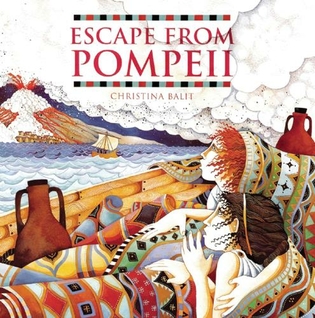

The story is engaging - sure to please young adventure lovers, it also gives the basic outline of the historical story of the destruction of Pompeii, something explored in more detail in the author's afterword. I tracked down Escape from Pompeii - it had to be requested through interlibrary loan - because of this fondness for Balit's work, and I was not disappointed.

I am a great admirer of the work of author/artist Christina Balit, and have enjoyed many of her books, from the wonderful folkloric and mythological retellings she has illustrated for other authors, to her own Atlantis: The Legend of the Lost City, which she both wrote and illustrated. Behind them was their home and their families, soon to disappear forever. He immediately set out in search of his friend Livia, the baker's daughter, and when the sky turned dark and began to rain down ashes, the two fled to the harbor, where they found safety on a ship setting sail. An alert and active boy, Tranio was the son of an actor, and was out and about when the earth in his home city began to tremble. Vesuvius erupted, in this engaging work of picture-book historical fiction. It gives a wealth of information about daily life in ancient Rome and the archaeological site of Pompeii.Two children survive the destruction of the ancient Roman city of Pompeii, buried beneath the ashes when nearby Mt. This book is particularly good for families who are planning to visit Italy. On the last page, the illustration shows the people who didn’t escape the eruption buried in the earth among the ruins as if they are sleeping, waiting to be excavated. Her illustrations are full of archaeological features, from the painted Latin street names down to the loaves of bread in the bakery’s oven. The book ends with an afterword that explains Pompeii’s history as an archaeological site and reassures readers that we are monitoring the volcano very carefully, so there’s no danger of another surprise eruption.Ĭhristina Balit is as devoted to getting the details right here as she is in all her books. There’s never any doubt that Tranio and Livia will make it out of Pompeii safely, and the story acknowledges the grief that comes with so great a loss. The eruption itself is terrifying and tragic, but Christina Balit handles it well. The locations that he visits-the port, the theater, and Livia’s family bakery- are all recognizable places in the excavated parts of the city. Tranio is the son of an actor, and he paints a vivid picture of life in a lively, thriving Roman port city before the volcano erupts. Vesuvius that buried the ancient Roman city of Pompeii from the point of view of a young boy named Tranio and his friend Livia.

This book tells the story of the eruption of Mt.


 0 kommentar(er)
0 kommentar(er)
